
Actaeon, in Greek mythology, was the son of the priestly herdsman Aristaeus and Autonoe in Boeotia, and a famous Theban hero. Through his mother he was a member of the ruling House of Cadmus. Like Achilles, in a later generation, he was trained by the centaur Chiron.

In Greek mythology, Cerberus, often referred to as the hound of Hades, is a multi-headed dog that guards the gates of the Underworld to prevent the dead from leaving. He was the offspring of the monsters Echidna and Typhon, and was usually described as having three heads, a serpent for a tail, and snakes protruding from multiple parts of his body. Cerberus is primarily known for his capture by Heracles, the last of Heracles' twelve labours.

Hercules is the Roman equivalent of the Greek divine hero Heracles, son of Jupiter and the mortal Alcmena. In classical mythology, Hercules is famous for his strength and for his numerous far-ranging adventures.

Heracles, born Alcaeus or Alcides, was a divine hero in Greek mythology, the son of Zeus and Alcmene, and the foster son of Amphitryon. He was a descendant and half-brother of Perseus. He was the greatest of the Greek heroes, the ancestor of royal clans who claimed to be Heracleidae (Ἡρακλεῖδαι), and a champion of the Olympian order against chthonic monsters. In Rome and the modern West, he is known as Hercules, with whom the later Roman emperors, in particular Commodus and Maximian, often identified themselves. Details of his cult were adapted to Rome as well.

In Greek mythology, Scylla is a legendary monster who lives on one side of a narrow channel of water, opposite her counterpart Charybdis. The two sides of the strait are within an arrow's range of each other—so close that sailors attempting to avoid Charybdis would pass dangerously close to Scylla and vice versa.
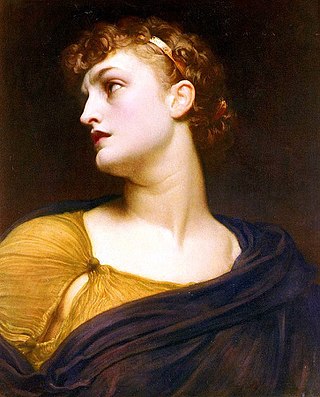
In Greek mythology, Antigone is a Theban princess and a character in several ancient Greek tragedies. She is the daughter of Oedipus and either his mother Jocasta or, in another variation of the myth, Euryganeia. She is a sister of Polynices, Eteocles, and Ismene. The meaning of the name is, as in the case of the masculine equivalent Antigonus, "worthy of one's parents" or "in place of one's parents". She appears in the three 5th century BC tragic plays written by Sophocles, known as the three Theban plays, and she is the protagonist of the eponymous tragedy Antigone.
Ibycus was an Ancient Greek lyric poet, a citizen of Rhegium in Magna Graecia, probably active at Samos during the reign of the tyrant Polycrates and numbered by the scholars of Hellenistic Alexandria in the canonical list of nine lyric poets. He was mainly remembered in antiquity for pederastic verses, but he also composed lyrical narratives on mythological themes in the manner of Stesichorus. His work survives today only as quotations by ancient scholars or recorded on fragments of papyrus recovered from archaeological sites in Egypt, yet his extant verses include what are considered some of the finest examples of Greek poetry.
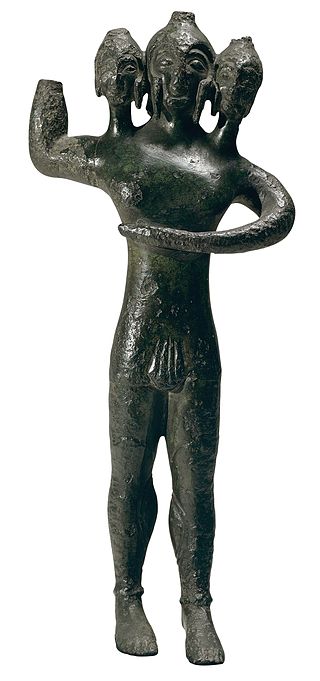
In Greek mythology, Geryon, son of Chrysaor and Callirrhoe, the grandson of Medusa and the nephew of Pegasus, was a fearsome giant who dwelt on the island Erytheia of the mythic Hesperides in the far west of the Mediterranean. A more literal-minded later generation of Greeks associated the region with Tartessos in southern Iberia. Geryon was often described as a monster with either three bodies and three heads, or three heads and one body, or three bodies and one head. He is commonly accepted as being mostly humanoid, with some distinguishing features and in mythology, famed for his cattle.

In Greek mythology, Orthrus or Orthus was, according to the mythographer Apollodorus, a two-headed dog who guarded Geryon's cattle and was killed by Heracles. He was the offspring of the monsters Echidna and Typhon, and the brother of Cerberus, who was also a multi-headed guard dog.

The Lernaean Hydra or Hydra of Lerna, more often known simply as the Hydra, is a serpentine water monster in Greek mythology and Roman mythology. Its lair was the lake of Lerna in the Argolid, which was also the site of the myth of the Danaïdes. Lerna was reputed to be an entrance to the Underworld, and archaeology has established it as a sacred site older than Mycenaean Argos. In the canonical Hydra myth, the monster is killed by Heracles (Hercules) as the second of his Twelve Labors.
Anne Patricia Carson is a Canadian poet, essayist, translator, classicist, and professor.

Corinna or Korinna was an ancient Greek lyric poet from Tanagra in Boeotia. Although ancient sources portray her as a contemporary of Pindar, not all modern scholars accept the accuracy of this tradition. When she lived has been the subject of much debate since the early twentieth century, proposed dates ranging from the beginning of the fifth century to the late third century BC.
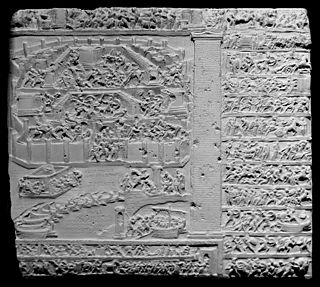
Stesichorus was a Greek lyric poet native of today's Calabria. He is best known for telling epic stories in lyric metres, and for some ancient traditions about his life, such as his opposition to the tyrant Phalaris, and the blindness he is said to have incurred and cured by composing verses first insulting and then flattering to Helen of Troy.
The princess Celtine or Celto is the protagonist of a Celtic ancestral myth that was recorded by several Graeco-Roman authors.

The Lille Stesichorus is a papyrus containing a major fragment of poetry usually attributed to the archaic lyric poet Stesichorus, discovered at Lille University and published in 1976. It has been considered the most important of all the Stesichorus fragments, confirming his role as an historic link between genres as different as the epic poetry of Homer and the lyric poetry of Pindar. The subject matter and style are typical of his work generally but not all scholars have accepted it as his work. The fragment is a narrative treatment of a popular myth, involving the family of Oedipus and the tragic history of Thebes, and thus it sheds light on other treatments of the same myth, such as by Sophocles in Oedipus Tyrannos and Aeschylus in Seven Against Thebes. The fragment is significant also in the history of colometry since it includes lyric verses that have been divided into metrical cola, a practice usually associated with the later career of Aristophanes of Byzantium.
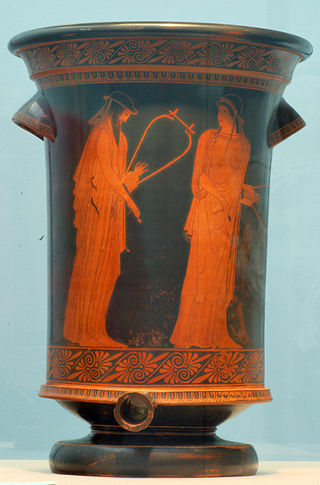
Greek lyric is the body of lyric poetry written in dialects of Ancient Greek. It is primarily associated with the early 7th to the early 5th centuries BC, sometimes called the "Lyric Age of Greece", but continued to be written into the Hellenistic and Imperial periods.
Eros the Bittersweet: An Essay (1986) is the first book of criticism by the Canadian poet, essayist, translator, and classicist Anne Carson.
In Greek mythology, Erythia or Erytheia or Erythea may refer to the following figures:
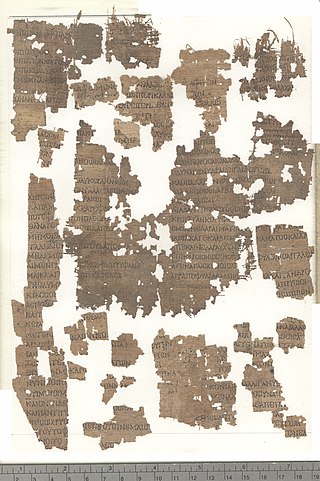
The "Geryoneis" is a fragmentary poem, written in Ancient Greek by the lyric poet Stesichorus. Composed in the 6th century BC, it narrates an episode from the Heracles myth in which the hero steals the cattle of Geryon, a three-bodied monster with a human face.

Red Doc> is a book by classicist and poet Anne Carson, which combines poetry, prose, and drama. Published in 2013, it resumes the story of her 1998 verse novel Autobiography of Red.















